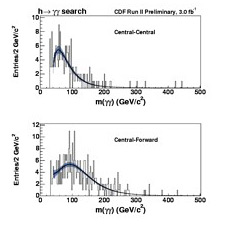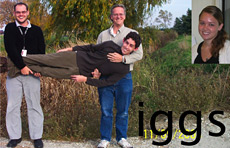High school student helps with Higgs search

If the Higgs boson was produced by a large enough rate of Tevatron collisions, it would be visible as a narrow bump in these distributions.
The Higgs boson is the last particle in the Standard Model to escape detection. In theory, this hypothetical particle is the cause of all mass. Recently, a group of CDF physicists chose to search for the Higgs by examining pairs of photons.
Two young students, one of them from a local high school, completed most of the work for this analysis. Under the direction of more experienced researchers, these students developed new skills and made important contributions to this result (see photo caption below). This arrangement was also a benefit to the CDF collaboration, adding a previously uninvestigated analysis channel.
Scientists expect within the Standard Model that the Higgs will decay into photon pairs less than two or three times for every thousand Higgs bosons produced, an event rare in itself. The Higgs is much more likely to decay into bottom quarks. So, why did the CDF team choose to use photons? The reason is that some theories beyond the Standard Model suggest that the Higgs may not interact with fermions, particles including electrons and quarks. This means that the Higgs can't decay directly to bottom quarks and would instead decay to photons more often.
In the diphoton mass distribution, the Higgs boson events would be visible as a very narrow peak. Unfortunately, no such peak was observed in the data (see the figure). Although a Higgs boson was not observed, the result allows scientists to exclude theoretical models that predict it should have been observed. This result excludes fermiophobic Higgs masses below 106 GeV/c2,the strongest exclusion to date from a hadron collider.
CDF scientists are currently working to apply this analysis to the Standard Model search. Once the extra Standard Model production modes are included and optimized, CDF scientists hope the diphoton channel will provide another illuminating result.
Read more about the analysis here.

Two students played major roles in this analysis: Callie Demay (top right), an undergraduate from the University of Illinois at Urbana-Champaign, helped optimize the analysis, and Jamie Ray (the horizontal bar of the H), a high school student from IMSA, assisted with the calculation of efficiencies and helped finalize the results. Craig Group (left) and Ray Culbertson (right), both of Fermilab, directed this analysis.
|